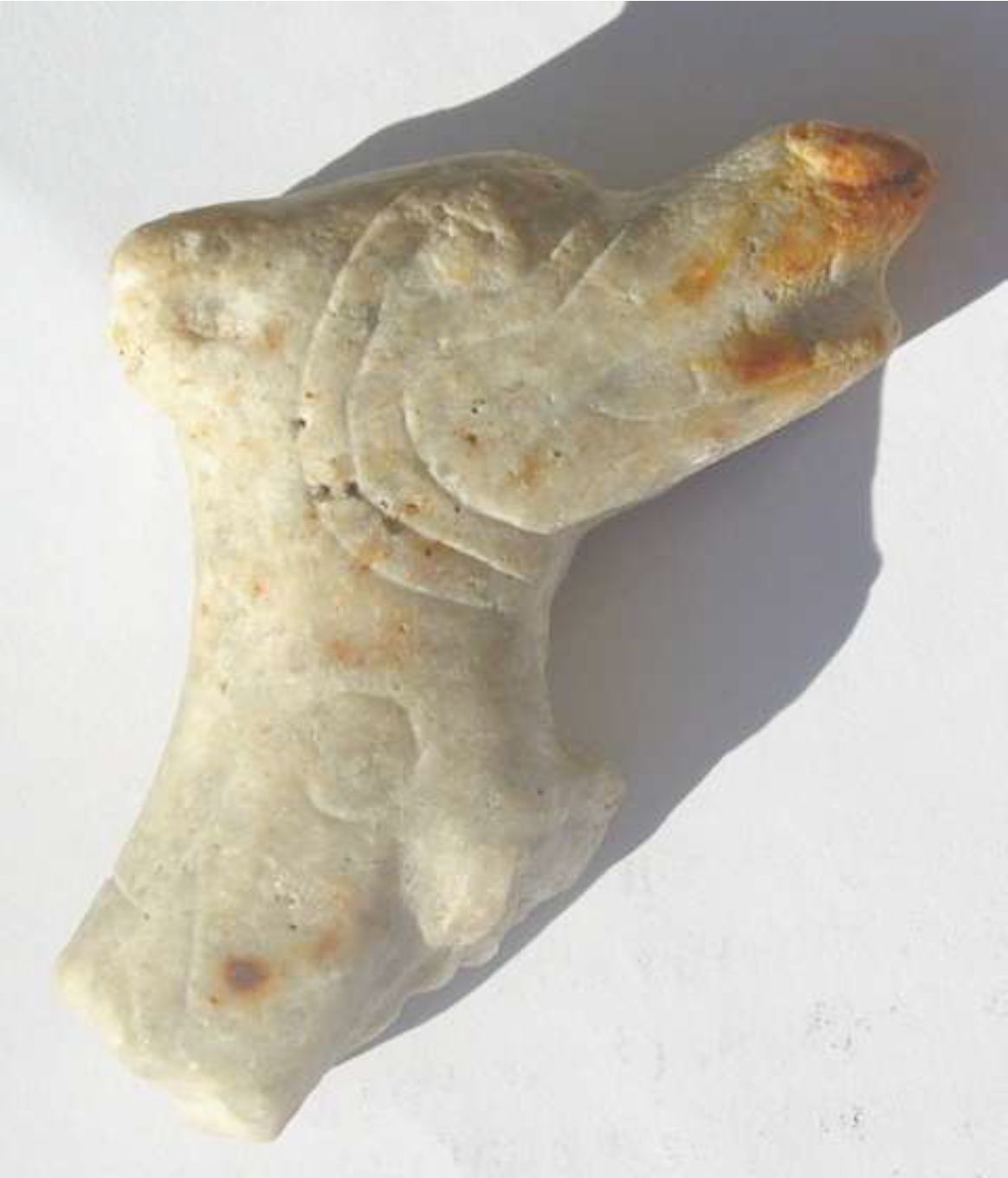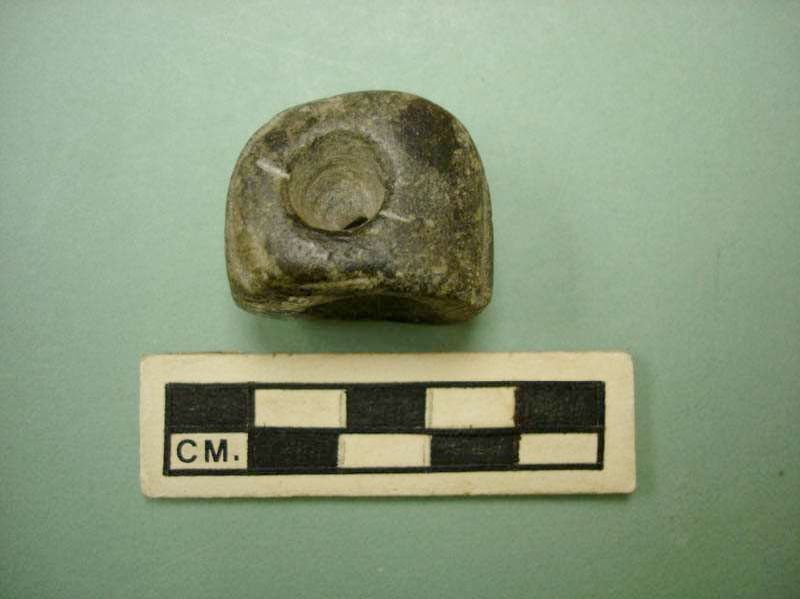By Grant Keddie. 2007.
Introduction
This document is a technical, descriptive summary of all atlatl weights currently in the collection of the Royal B.C. Museum and some from other collections. This information is provided here because of the rarity of these artifacts and the difficulty of finding comparative information on the topic.
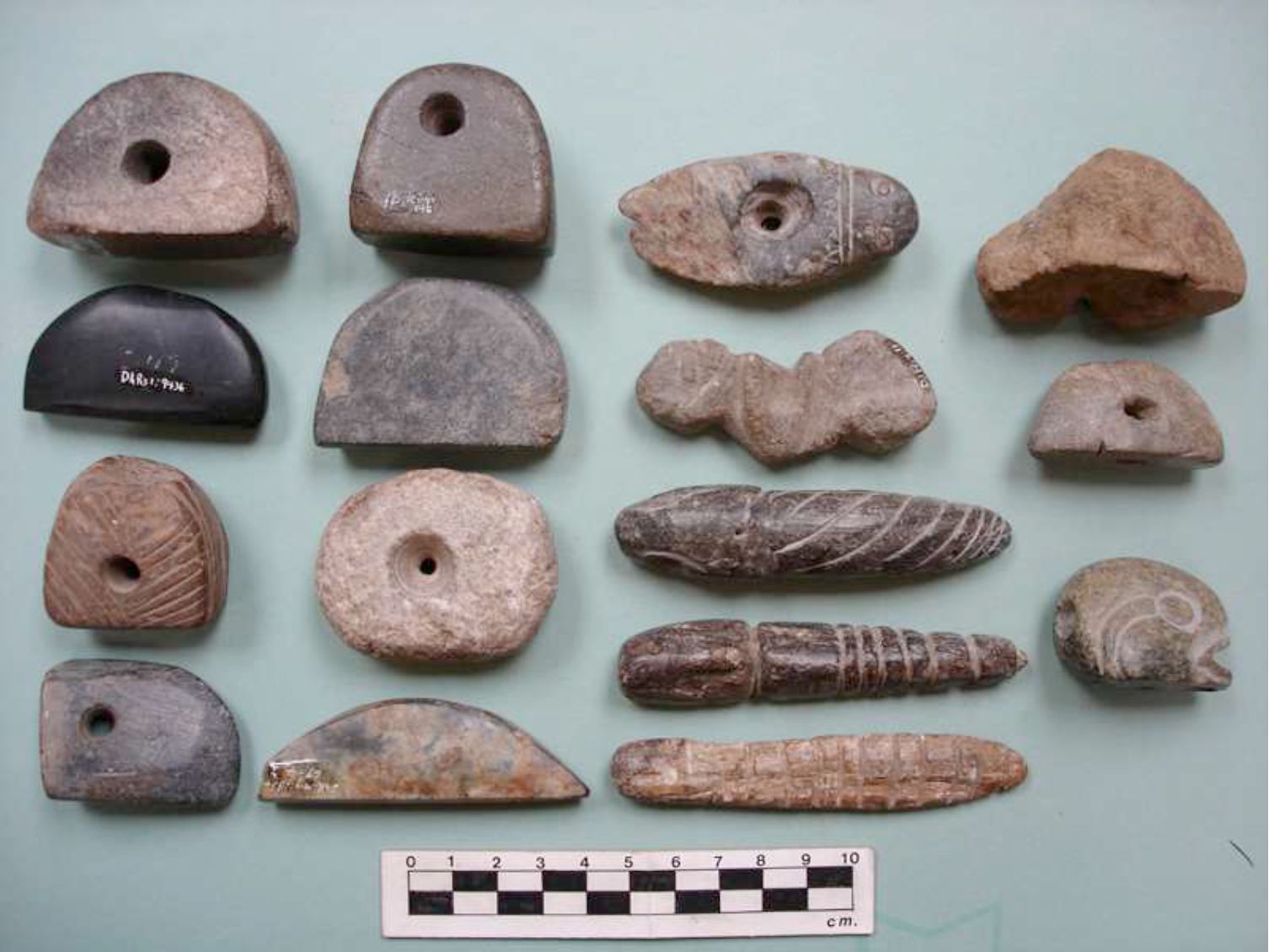
WHAT ARE ATLATL WEIGHTS?
An atlatl is a weapon composed of a flexible light spear or dart and a shorter throwing board that acts as a lever to propel the dart through the air. The weighting can be incorporated into the design of the throwing board, or represented as a separate item that is attached to these throwing boards.
The dart should be thought of as being more like a very large flexible arrow rather than the thicker, heavy and stiffer kind of spear that is thrown without the assistance of a throwing board. I will therefore use the term dart here for this light flexible spear. Both the darts and the throwing boards come in a variety of sizes and styles. They were used for hunting birds, fish, large mammals and against humans in warfare. The throwing boards themselves are often called atlatls. Here, I will use the term throwing board as one part of the atlatl device.
Atlatl throwing boards sometimes incorporate a weighted area carved into its distal end. This was most common in antler and wooden atlatls used in the Upper Palaeolithic period in parts of Europe. Animal figures were often carved into the design of the thicker distal end which functioned as a weighting device (see Guthrie 2002 for the best overview). Similar designed or built-in weights are found in carved atlatls in North America. One of these found near the mouth of the Skagit River in Northwestern Washington was dated to 1700+100 B.P. (RIDDL-86). (see Fladmark 1987; Borden 1969; Duff 1956; Taylor and Caldwell 1954).
Many throwing boards were composite with a separate (usually stone), weight that was attached on one surface toward the distal end. Most of the atlatls used in ancient times would be made of perishable organic materials such as yew wood or antler. Archaeologists are therefore most familiar with the large variety of stone weights that were once attached to these now vanished throwing boards. The reason we know these stone weights were once used as parts of atlatls is because of rare cases of specimens found in a unique state of preservation. Stone weights have been found still attached to normally perishable wooden atlatl boards buried in dry cave sites.
Other types of stone artifacts are identified as probable weights on the basis of their specific design characteristics and weathering patterns. More research will be needed to confirm that some of the objects described as atlatl weights are, in fact, weights. See the references at the end of this article for detailed information on those unique perishable specimens, and to see the known range of variation in weight styles.
WHY ARE WEIGHTS USED ON THROWING BOARDS?
This is a subject that has a long history of debate. See some of the references below to follow the interesting history of the debate.
The best answer to date is a complex one. The throwing board is a lever whose actions are made more stable by the effect of the weight. The proper weighting of the throwing board helps to improve accuracy by smoothing out the throw and in some cases increasing the velocity of the dart throw. The atlatl weight magnifies the amount of energy stored in the flexible dart shaft from the beginning of the throw to the final phases – thus increasing the final velocity. Put another way – the stone weight tunes the atlatl flex in relation to the spine of the dart. This results in the dart being propelled foreword with greater control.
The main premise is that the energy stored in the flexible dart, when thrown, causes it to spring away from the tip of the throwing board – the weight has an effect on how this happens. In addition, what actually happens is also dependent on complex relationships that take into account the length and thickness of the dart shaft, its weight, balance, and flexibility of the wood. From my own experience in using a variety of types of throwing boards with a variety of dart types, the basic premise is correct, but weights may have a varying impact on throwing accuracy. The size, strength and skill of the thrower, as well as the specific kind of hunting activity being undertaken are all factors involved in how the atlatl performs (see Perkins 1993 & 1994; Guthrie 2002).
The purpose of some decorative atlatl weights is, of course, also symbolic – with meanings that vary among cultures. Some preserved wooden atlatl boards have been found with small ornamental attachments. Some look like mini atlatl weights, but due to their light weight, can only be symbolic or purely decorative.
BRITISH COLUMBIA
The Royal B.C. Museum’s mandate is to have collections only from British Columbia. There are other atlatl weights at the University of British Columbia Museum of Anthropology and a few atlatl weights at other Archaeological repositories and community museums. Two specimens from Simon Fraser University Archaeology Museum will be reported here.
Atlatl weights have a limited distribution in parts of southern British Columbia. This includes the southern end of Vancouver Island, the Gulf Islands, Lower Fraser River to the Fraser River Canyon, and in a few scattered locations from the Similkameen and Okanagan valleys to the Kootenay Lake area. They are more prevalent to the south of the Canadian Border and have obviously made intrusions into British Columbia from there. They seem to appear on the southern coast for only a short time period between about 2000 and 1700 years ago or less, but most of these artifacts remain undated.
THE COLLECTIONS
MEASUREMENTS
All weights are given to the nearest gram. All measurements are in millimetres (mm). Measurements include maximum base length and width, as well as maximum length, width and height of the body. The top is described as the upper portions of the body – which is usually flattened to rounded. When a tying hole exits, the diameter of the outer part of the
perforation hole is taken, as well as the diameter of the inner hole. When grooves or cut lines exist, the distance of the tie line or groove from at least one distal end is give. The distance between the bottom of hole and base is given.
SOUTHERN VANCOUVER ISLAND
• DcRt9:1343. Cadboro Bay. Weight: 62 grams. Elongated, D-Shaped weight. Flat Base: L. 80mm (small parts of ends missing – original length c. 84mm); W. 21mm (section along part of one side of base is missing, but width would be same width as body). Body: (L&W same as base); H 30mm. Hole dia. 8mm; hole to base 6mm; Flat sides rounded over top. Raw material: Serpentine? This specimen from the Robert Harris collection comes from the west side of the property at 3757 Waring Place road. A small creek that once ran here has been enclosed in pipes. There appears to be an older component of DcRt9 in the lower deposits at this part of the site. This location is where all of the microblades from the site have been found. The oldest date from this site would suggest that this weight is about 1800 years ago.
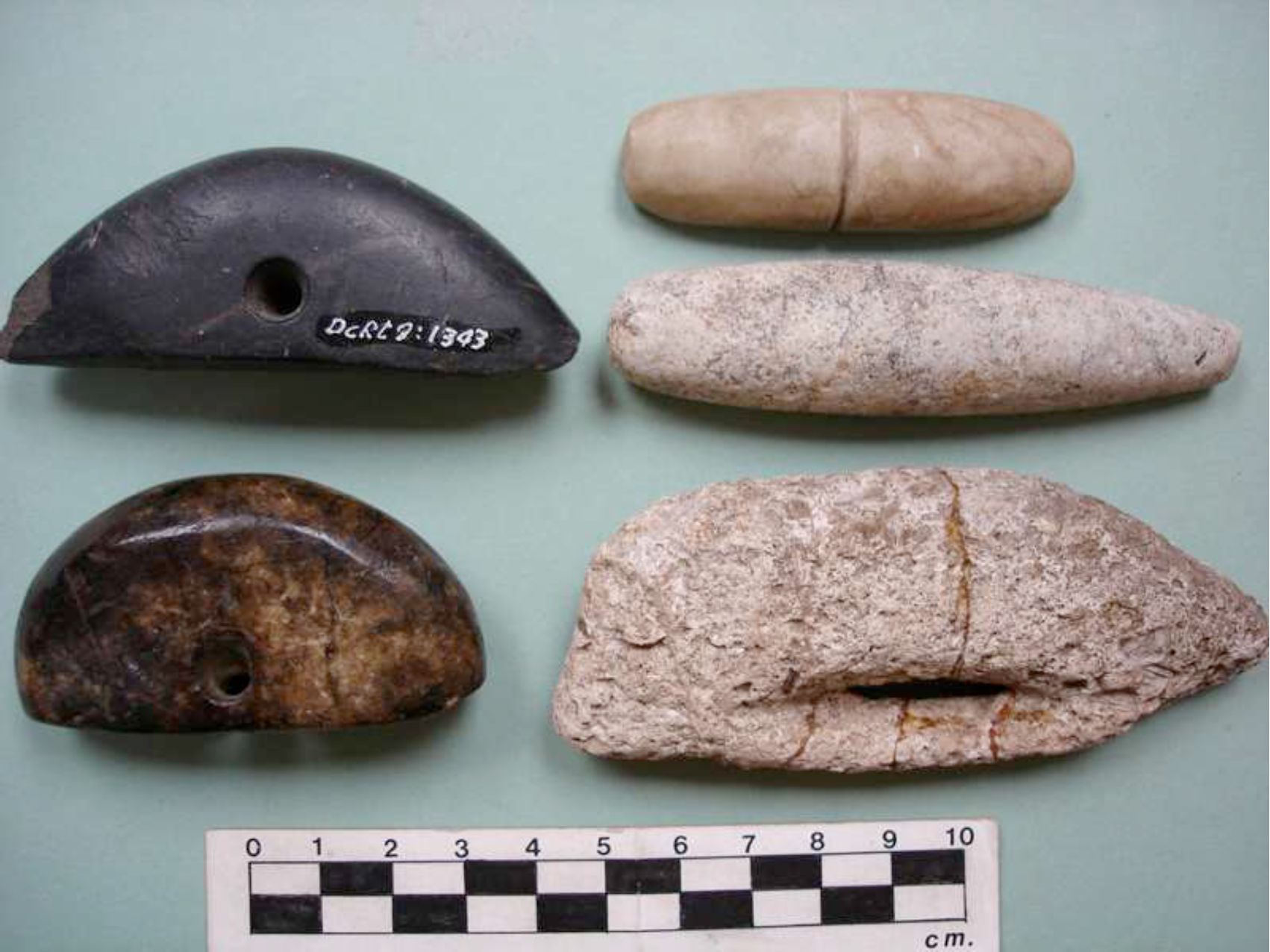
• DcRt 9:58. Cadboro Bay. Weight: 54 g. Elongate, tapering, half cylinder shaped weight. Flat base: Max. L. 87mm, W. 18mm. Rounded body: L. 91mm, W. 21.8mm, H. 17.5mm. The body tapers from the center to a width of 12mm at the thick end and 9mm at the narrow end. No tying element present. Raw material: White Quartzite. Robert Harris collection. An estimated date would place this weight to about 1800 years ago.
• DcRw2:19 (old #8769). Sooke. Half round shaped weight. Weight: 31 grams. Base: L. 65mm. W. 19mm; Rectangular nearly flat base with slightly convex ends. Body: L. 65mm. W. 20mm; the elongate rounded body has a central 1-2mm wide groove extending around it that terminates at the base. The groove is 34mm from one end. Raw material: white quartzite.
• DdRv2:4 [old #4586]. Saanich Inlet, McKenzie Bight. Elongate D-shaped weight. Weight: 110.65 grams. Base L. 54mm; W. 11-14mm. Body L. 102mm; W. 21mm; H. 41mm. A slightly extending (3mm) base, shorter in length than the body has a cut groove tie hole above it. The elongate tie hole is 21mm long, but the larger groove is 56mm long on one side and 43mm on the other. Thickness between tie hole and base is 11mm. The specimen has a slight Zoomorphic look to it. Raw material: fossiliferous limestone.
• DcRv48 (no number). Sooke Basin. Elongate D-shaped. Weight: 72.3 grams.Base L. 63mm; W. 1.85mm. Body L. 6.35mm; W. 2.45mm; H. 3.4mm. The thickness increases from the base to the upper flat part of the body – which rounds onto the top. Small .4mm bevel along one side of base. A tie hole (.9mm outer dia. and inner dia. .55mm) is located near the center on both sides of the body where they angle down to join a basal hole 1.3mmx1.1mm in dia. and . 7mm deep. Distance from base of body to base of tie hole .55mm. Private collection. Raw Material: Steatite.
GULF ISLANDS
• DgRw4: 1042 & 1266 (parts of same). Gabriola Island. Weight: [55 grams]. Two non-joining pieces of a slotted animal shaped weight. Includes back part with the tail and hind legs (L. [64mm], W. 18.5mm, H. [30mm]) and the front legs and chest area (L. [36mm], W. 13.5mm, H. [29.5mm]). It has a flat base with a parallel slot as the tying element. The base is 8mm wide at the distal (front) end and 12mm at the proximal (back) end. Incised ribs are on the chest area. Raw Material: White marble. Notes: Shown in Burley 1989, figure 28 g, p. 28 as “Effigy carvings”. Associated with False Narrows 1 component, p. 95. It pre-dates A.D. 240+- , which is the only date for False Narrows II component. [Burley, David. 1988. Senewelets. Culture History of the Nanaimo Coast Salish and the False Narrows Midden. Royal British Columbia Museum. Memoir No. 2, 1989].
• DfRu8:4321. Mayne Island. Helen Point. Distal section of animal shaped slotted weight. Weight: [30.4] grams. . L. [58mm], W. 13.8mm, H. [28.8mm]. This is similar to the specimenDgRw4:iO42 which is also the back feet and tail section of an animal. It has a flat base with a parallel slot as the tying element. The base is 12.5mm wide. Raw Material: White marble.
Orcas Island examples. A more complete specimen of the slotted type atlatl weight with a bird-like head was found on Orcas Island, as well as a fragment of a second example with a wolf-like head. These were brought to my attention by Norm Exton of Orcas Island, who provided images and measurements. They are made of a white marble similar to those from the northern Gulf Islands. These are shown here for comparative purposes.
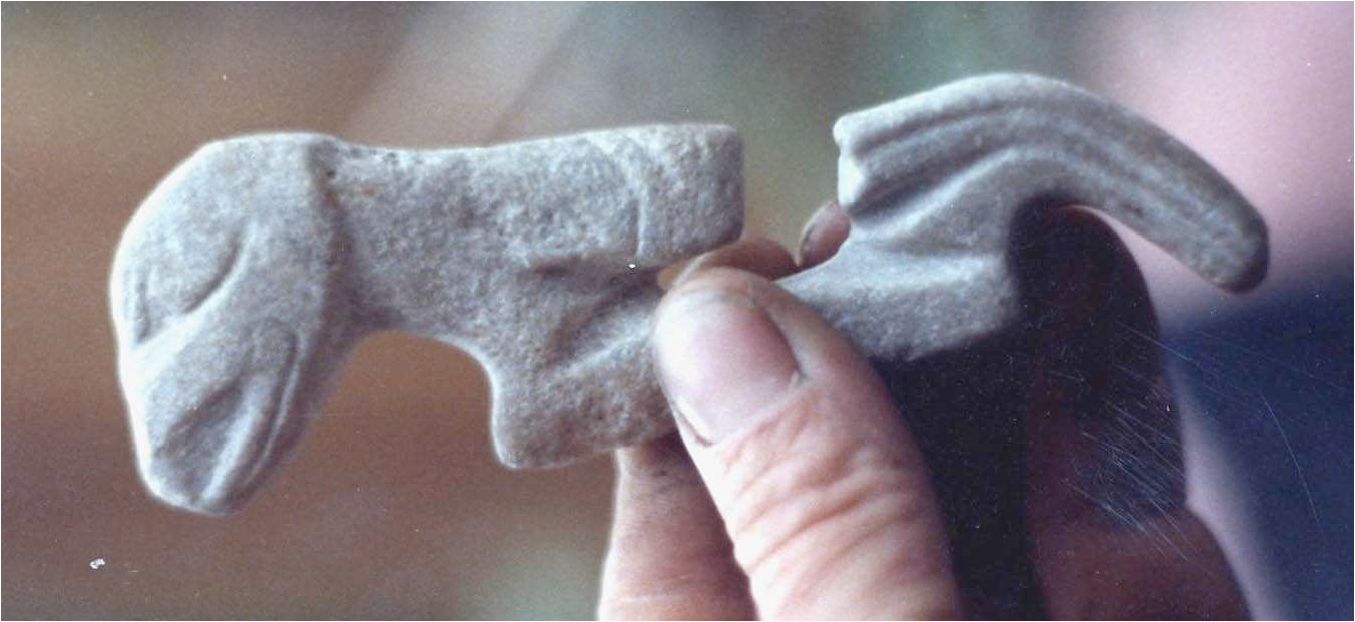
The Orcas Island bird-like weight is from site 45-SJ133 on West Sound Bay. Maximum L. 135mm. Maximum L. of base 65mm. Height at middle of body 35mm. Head L. 40mm. Average body width c. 15mm. The wolf-like weight is fragmentary. It is believed to also be from site 45-SJ133, based on the fact that the original owner lived at this location. This portion of a figure has a remnant of a slot just above the broken-off leg. There is a spiral design above the front leg. A double form line extends around and across the eyes and down under the chin of the animal – reminiscent of similar lines on some of the seated human figure bowls found on the southern coast.

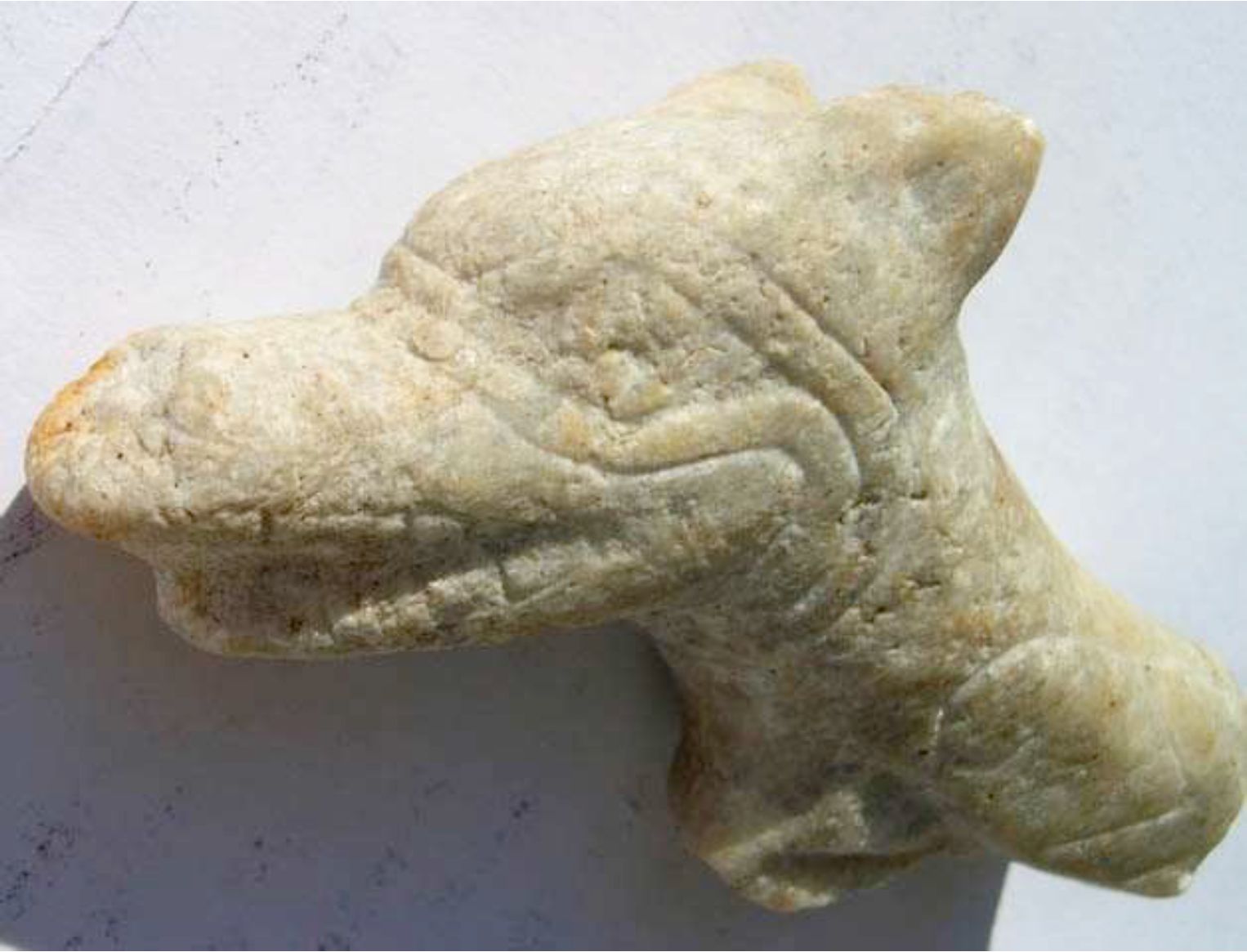
• DeRti2:i2 [old #8922] [Pender Island, N. E. Browning Harbour]. D-shaped weight. Weight: 186 grams. Base 73×40; Top 74×40. H45mm. Hole dia. 8mm; Hole to base 7mm; slightly flattened 13mm surface around top of body. The oval shaped base is hollowed out, over an area of 42x28mm- tapering to a depth of 14mm. The thin sidewall area around one hole has broken off. Raw material: Quartzitelike material. Surface collected by RBCM staff in 1958.
• DeRt-Y:142. [old #11848]. Pender Island. Elongate D-shaped. Weight: 57 grams. Base: L. 68mm. W. 7mm. Body: L. 70mm. W. 21mm; height 30mm. Narrow flat base with slightly excavate sides that round onto a flattened top area. The flattened top area ranges from 15mm wide at the middle to 3mm at the base. The hole was drilled too close to the base, resulting in its breakage. A second small 4mm drill hole was started above the first hole on one side. The original hole is 3mm diameter on the inside with a wider hole entrance being 7mm on one side and 5mm on the other. This is from DeRt 11 – “found just west of government wharf in Browning harbour”. Donated by Edith Cross, Nov. 21, 1963. Raw material: white quartzite.
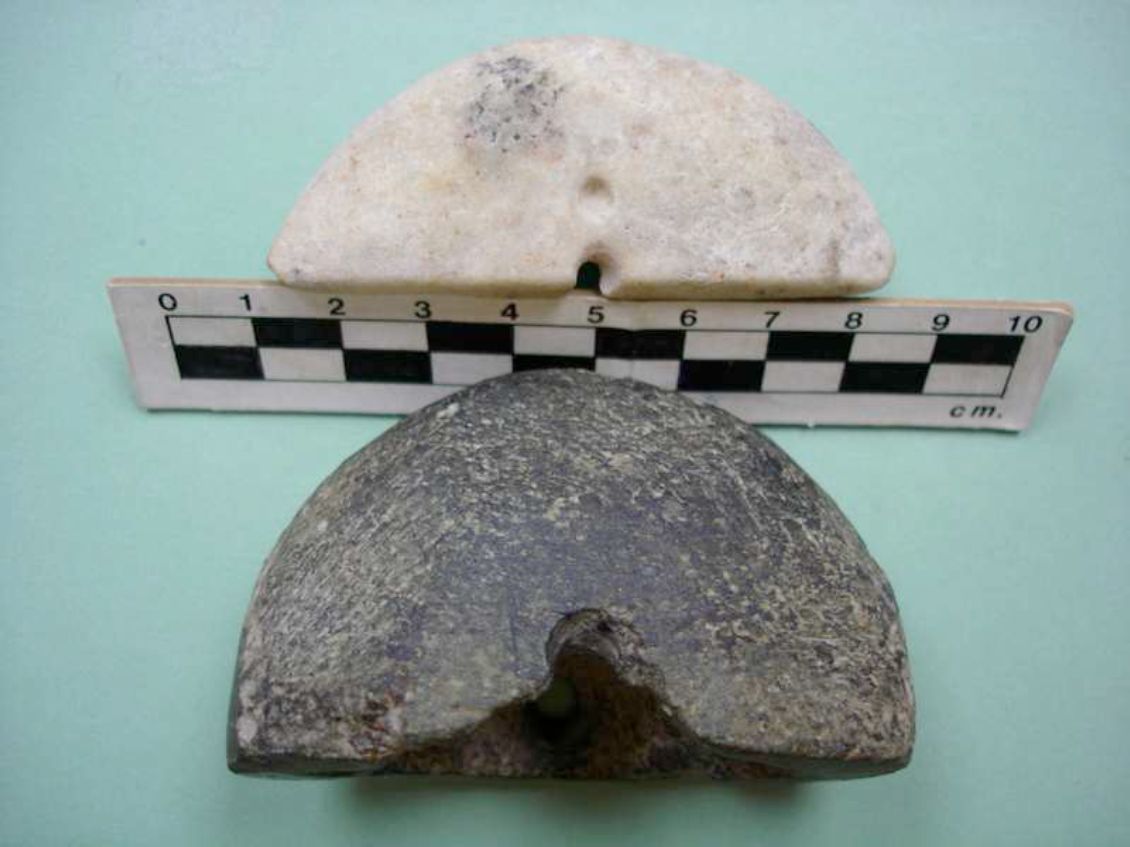

FRASER RIVER VALLEY TO FRASER CANYON
• DhRs1:9469 [old #8682]. Vancouver. D-shaped weight perform. Weight: 90 grams. Base 58×25; Top 58×25; H 38mm; hole dia. 11mm; hole to base 12mm. Flat sides with 16mm flattened area on top that widens to base. Raw material: Nephrite. Surface collected by John Sendy.
• DhRsi:9436. [old #8682]. Vancouver. D-shaped weight preform. Weight: 39.1 grams. Unfinished weight blank with no hole. Base: l. 54mm; W. 11mm. Body l. 55mm; W. 13mm; H. 30mm. A flat 8mm wide surface extends around the top. Remains of a sawn edge visible on edge of base. This appears to be a remnant from the sectioning of nephrite for making adze blades. Adzes from this site are made from the same kind of sawn nephrite. Material: Nephrite. From collection of Captain L.A. Peck.
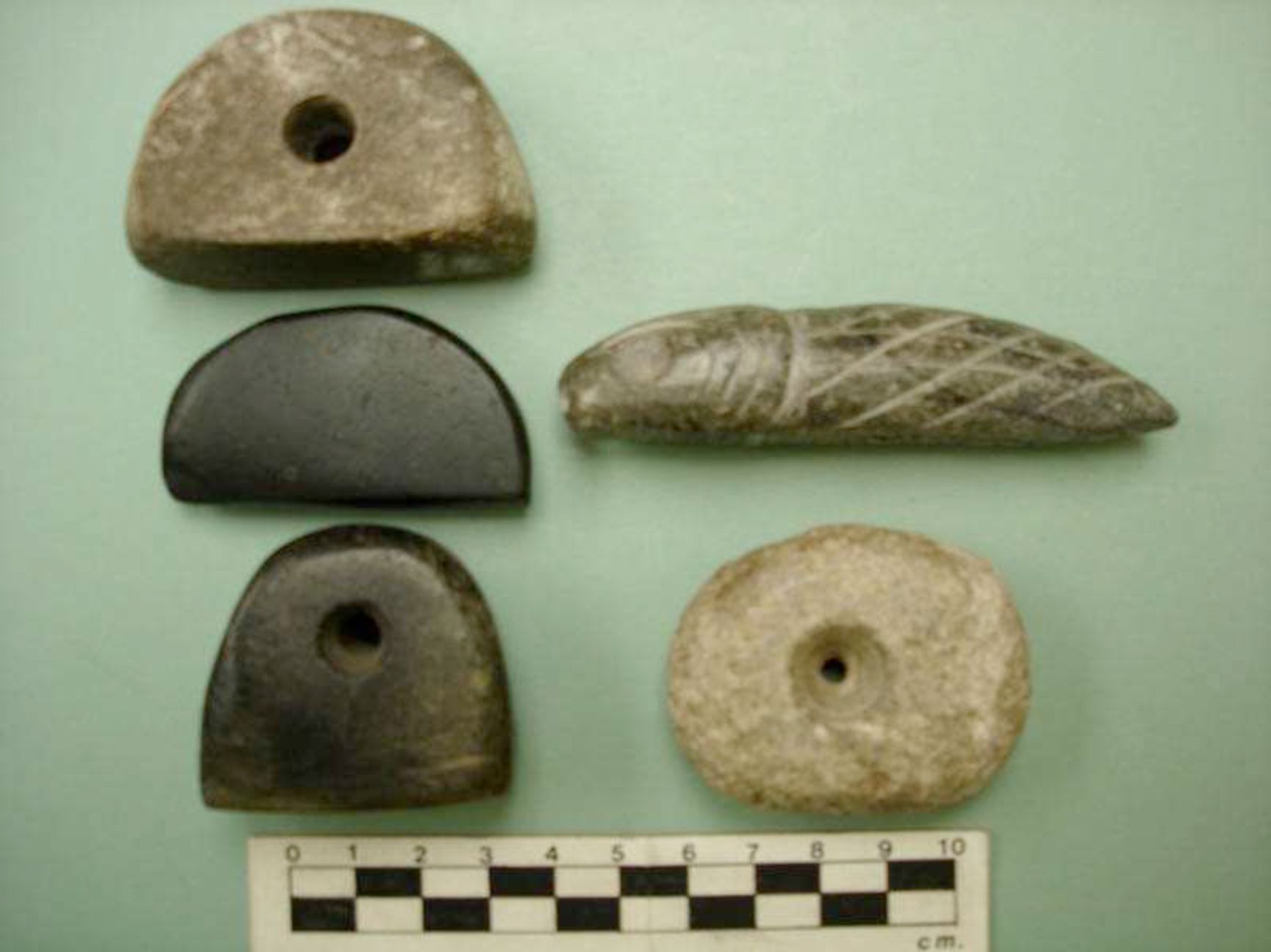
• DR-Y. (old #2521; accession #1913-21). Lower Fraser River. D-shaped. Weight: 80 grams. Base 44x24mm; slight 1mm concavity covering base surface. Body L. 44mm; W. 24mm: H. 39mm. Flat sides, with flat 18mm wide surface around top that widens to the base. Hole dia. 10mm; hole to base 19-21mm. Donated by C. F. Newcombe – from his Andrew’s collection. This artifact was re-catalogued as DjRi-Y:146 in the Yale area, but there is some uncertainty as to the location – the original catalogue has “Lower Fraser”. Raw material: steatite.
• DR-Y. Lower Fraser River area. Weight: 59 grams. Half round shaped in carved animal form. Base: L. 89mm. W. 13mm; Body: L. 89mm. W. 21mm; H. 20mm; The animal shape has an elongated body with a head (head part 32mm). The base is snake-like with a continuous row of lines across the base (with a curved central line) up to the head. The head is tadpole-like with gills, large eyes and nostrils. There is a tiny 2mm hole at the back of the top of the head (c. 4mm deep). Donated by C.F. Newcombe 1913-22 – from his Mitchell Collection. Given borden number DjRi-Y:144 for the Yale area, but the original catalogue says: “Lower Fraser”. Raw material: steatite.

• DR-Y. (old # 2517). Lower Fraser River. Weight: 75.4 grams. Oval shaped weight with hole through centre. Possible unfinished weight. Base straight and slightly concave rather than flat: L. 46mm. W. 19mm. Body: L. 52.3mm. W. 19.2. H. 41.5mm. Biconically drilled holes. Inside hole 3.3mm. Outside hole: 12mm. Distance from outer hole to base 13mm. Raw Material: Chlorite schist. Donated by C. F. Newcombe, 1913.
• DR-Y (DjRi-Y:146). Right: DR-Y (DjRi-Y:144) and DR-Y (old number 2517).
DgRn-Y:15 Mission area. D-shaped. Weight. 140 grams. Base 57×3.2; Top 61×34. H.41mm. Hole dia. 1.5cm. Hole to base 14mm. Other features: Expanding 1mm deep flat groove on each side below hole to facilitate hafting, 1o-21mm on one side and 8-14mm on other side. Top design pattern made by three spaced lines around entire top of body with nine main cross- lines and portions of other cross-lines. Raw material: steatite.
Five examples of weights were originally part of the Gerald Mitchell collection. Most of his collection comes from around the area of Duroche. They were collected by Gerald Mitchell from his farm and nearby sites in 1910.
• DhRlm-Y: 1837 (accession #67-4). Duroche. D-shaped. Weight: 47.2 grams. Flat base: L.
35mm. W. 16mm. Body: L. 37mm. W. 24mm. Attachment hole, biconically drilled; inside dia.
5mm, outside hole cut 8mm on both sides. Centred hole is 10mm from base. Nearly flat side of body round into flattened top. The flattened area of the top varies from the base width up to a maximum of 22mm. Four main and other partial grooves extend around the top to each end of the base. Angled lines cover both sides of body. Some grooves join to a straight line that extends from the top of the body sides to the attachment hole, others extend to the hole or below it. A 11mm piece is missing from the top of the body. Material: Sandstone.

• DhRlm-Y: 1842 (accession #67-4). Derouche. A 1/2 D-shape. Weight: 33.5 grams. One end is nearly straight with the top gradually tapering and then curving to the base on the other side. Flat Base: L. 39mm; W. 18mm. Body L. 44mm; W. 18mm; H. 32mm. Distance between tying hole and flat end 10mm. Material: Nephrite.
• DhRlm-Y: 1854 (accession #67-4). Derouche. D-shaped preform. Weight: 32.2 grams. Unfinished weight, no tying hole. Base [L. 73mm, small piece missing – probable length 78mm]; W. 12.5mm. Body: L. (same); W. 12.5mm; H. 23mm. Material Nephrite. Storage Location: 17.A009.
• DhRlm-Y:1601 (accession #67-4). Derouche. D-shaped preform. Weight 66.3 grams. Base l. 54mm; W. 13mm. Body L. 55mm; W. 14.6mm; H. 36.5mm. Material: Nephrite.
• DhRlm-Y: 1824 (accession 67-4). Derouche. Zoomorphic shape. A seal wearing a necklace. Weight: grams. Body: L. 66mm; Width 31mm; Thickness 16.8mm. Attachment hole is from top to bottom. Inner hole dia. 5mm; outer hole cut dia. on dorsal side 13mm and on ventral side 9mm. The upper portion above flippers is broken off. The necklace design is a double line with a continuous line of small triangles on the back line. It extends around the neck to the hole on the ventral surface. There are two tail flippers represented and side flippers divided into three parts. The area below the back end has a wide groove intended to help define the flippers. A small 4mm concavity is located on each side of the attachment hole on the base. The ventral surface of the figure has a flat area about 20mmX22mm that can be defined as its base. Raw Material: Steatite-like.
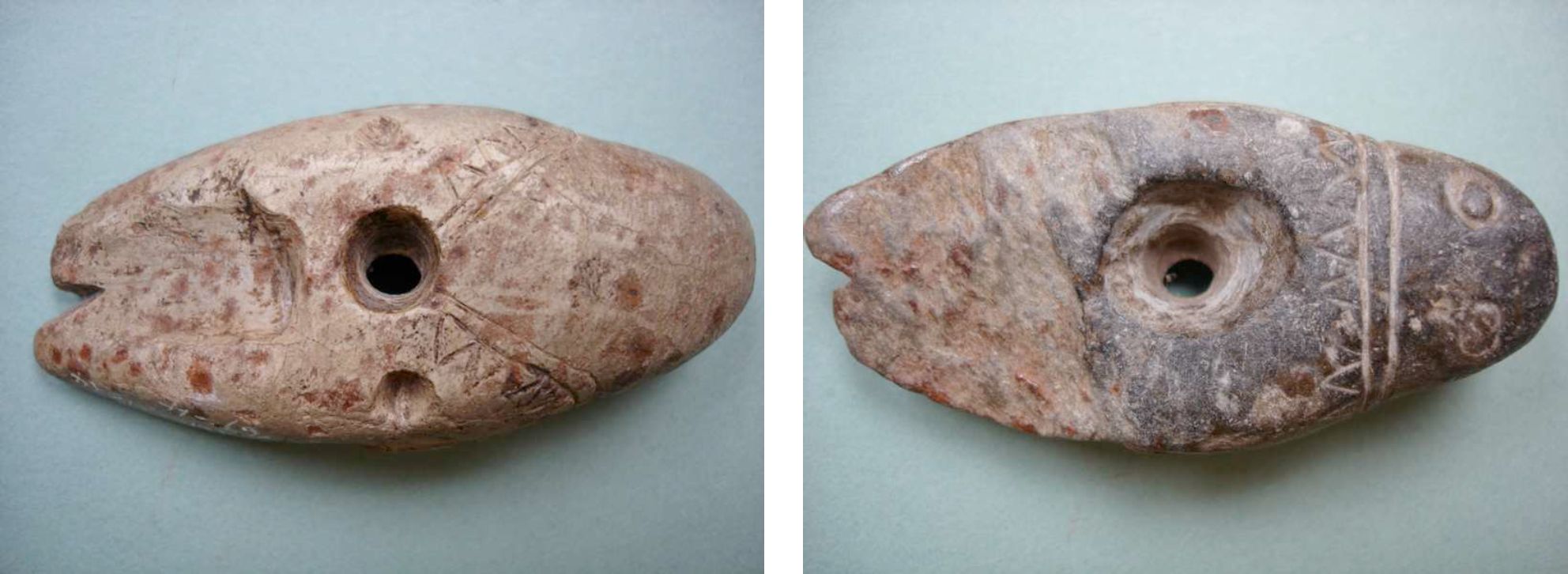
HATSIC LAKE
Two D-shaped weights from “Hatzic Lake Beach” are the only atlatl weights in the collection of Simon Fraser University Anthropology Museum.
• 93.1.1253. D-shaped weight. Weight: 60.3 grams. Body: L. 51mm; W. 25.5mm; H. 30mm. Base: L. 50mm; W. 25.5mm; Inner hole 6mm. Outer hole 11-12mm. Base hole to base of body is 9mm. The design includes 9-10 triangles along each side of a double groove on the top of the body. The two grooves are continuous. An eight extension star pattern surrounds that tie hole. Material: steatite.
• 93.1.1252. D-shaped weight. Weight: 63.1 gram. Body: L. 52.5mm; W. 26mm; H. 32.5mm. There is a 17mm by 24mm flattened area on the top of the body. Grooves are cut up th ends and across the top of the body. There are 7 grooves on each side in a ray pattern extending from the tie hole. One of the tie holes is broken through on one side. Base of hole to base of body 9mm. The base is hollowed out to a maximum depth of 14mm. Base: L. 51mm; W. 26mm. Material: sandstone.
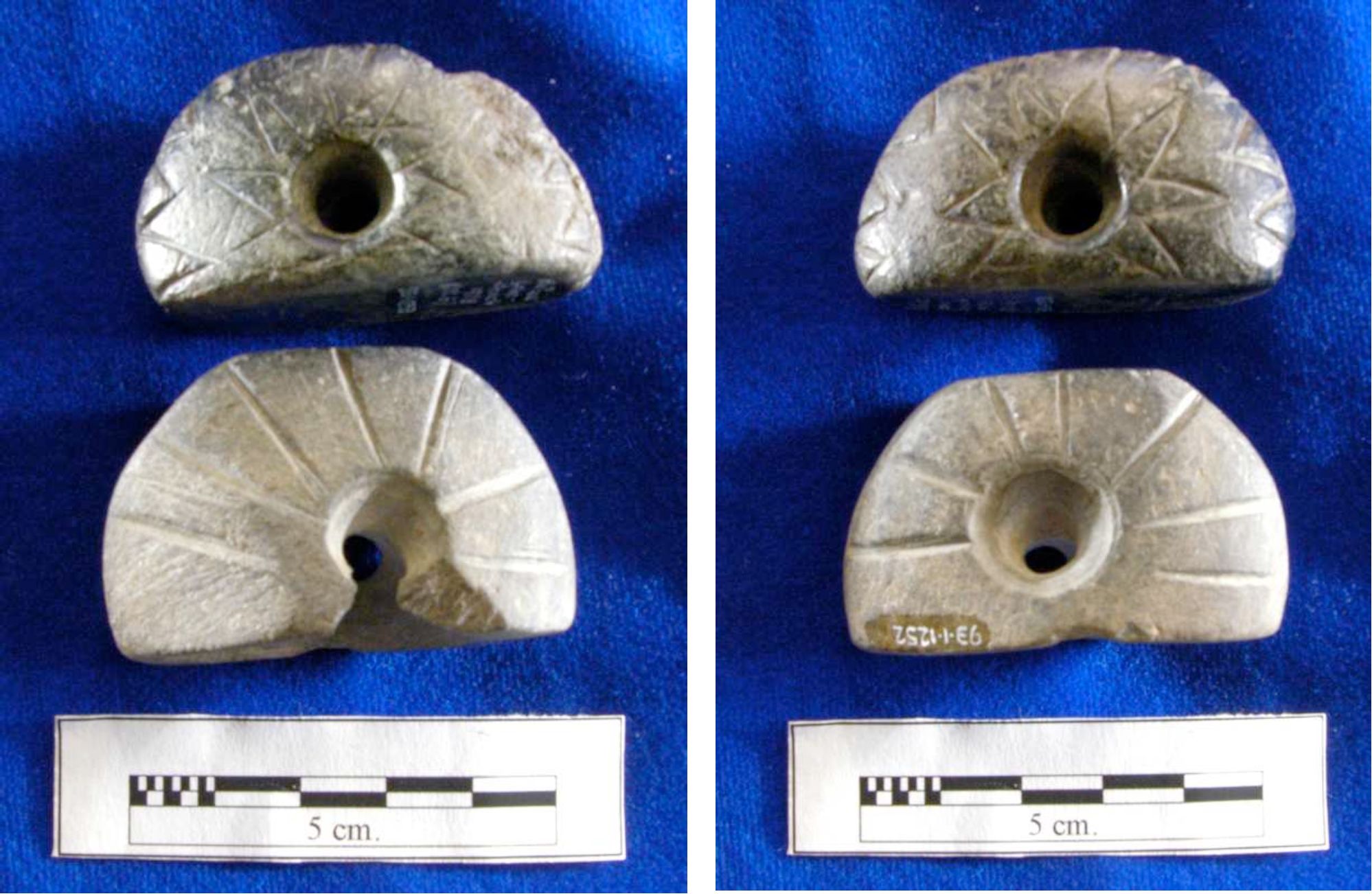
HOPE REGION
• DiRi14:55. Hope area. D-shaped. Weight: 74 grams (incomplete). Base: L. 61mm (about 70% present – original length c. 68mm); W. 33mm. Concavity in base covering an area of 20X30mm that tapers to depth of 7mm; side of base between hole and concavity broken off on one side. Body. L. approx. 4mm longer than original base; H. 40mm. Hole dia. 5mm; hole was drilled downward at c. 45 degree angle; measurement from hole to base 5mm. Slightly concave sides with 8mm flattened area around top. Raw material: sandstone. Provenance and Dating: This artifact was recovered from a systematic excavation project in 1977-78. It was recovered in component 2 of sampling stratum V of excavation unit 2 at DiRi4:55. Stratum V just below the disturbed layer in unit 26 has a date of 670+ or – 120 B.P. (Gak 7442) [This may provide a not-later-than date]. The two dates from stratum IV (below V) for component 2 are 2310+or-120B.P. (Gak 7439) and 2790+or-140B.P. (Gak7440) [These may provide a not-earlier- than date]. Reference: The Hope Highway. Archaeological Salvage Project, by Morley Eldridge. In: Annual Research Report I, Selected Research Reports and Activities of the Heritage Conservation Branch for the Year 1978. Province of British Columbia, Ministry of Provincial Secretary and Government Services. Heritage Conservation Branch, pp. 53 – 110, Victoria, 1981.
• DiRi 1:2770 (accession 72-295) [Hope Beach]. D-shaped. Weight: 30.1 grams. Base: L. 46.3, W. 18.5mm. Body: L. (same); W. 18.5mm; H. 24mm. Slightly concave sides round across the top, with the exception of a 9mm wide by 20mm long flattened portion along the top on one side. Joining rectangular side holes, also join to hole extending from the centre of the base. Side and base holes 4mmX6mm. Distance from the base of a side hole to the base is 9.5mm. The distance from the base hole to the side of base is 7mm. The base hole is nearly centred being 19mm and 21mm from edge of hole to the base ends. There is a 5mm asymmetrical cut partly on the side and bottom corner on both sides of the weight. Material: Schist. Archaeological Sites Advisory Board Survey, Sept. 1972.
• DiRi38:1. Hope area. D shape in the form of a Fish head. Weight: 40.5 grams. Base; L. 39mm, W. 23mm. Body: L. 41.5mm; W. 23mm; H. 30mm. The eye (outer 10mmX12mm) is formed by a circular incision that extends out from the back of the eye to the base of the head. The inner raised eye is ymmX9mm. The head has a pierced nostril. The open mouth has a 3mm diameter hole extending through and widening to a 7mm hole at the base of the mouth. The front of the mouth is highly polished at the hole suggested that a cord was tied through the hole. An unfinished 5mm diameter drill hole is found at the centre of the base and a 7.5 mm drill hole is located near the centre of the back of the head. Notes: surface collected at a house pit village site. Reference: Hope Archaeological Project. 1974. H Von Krogh 1975.
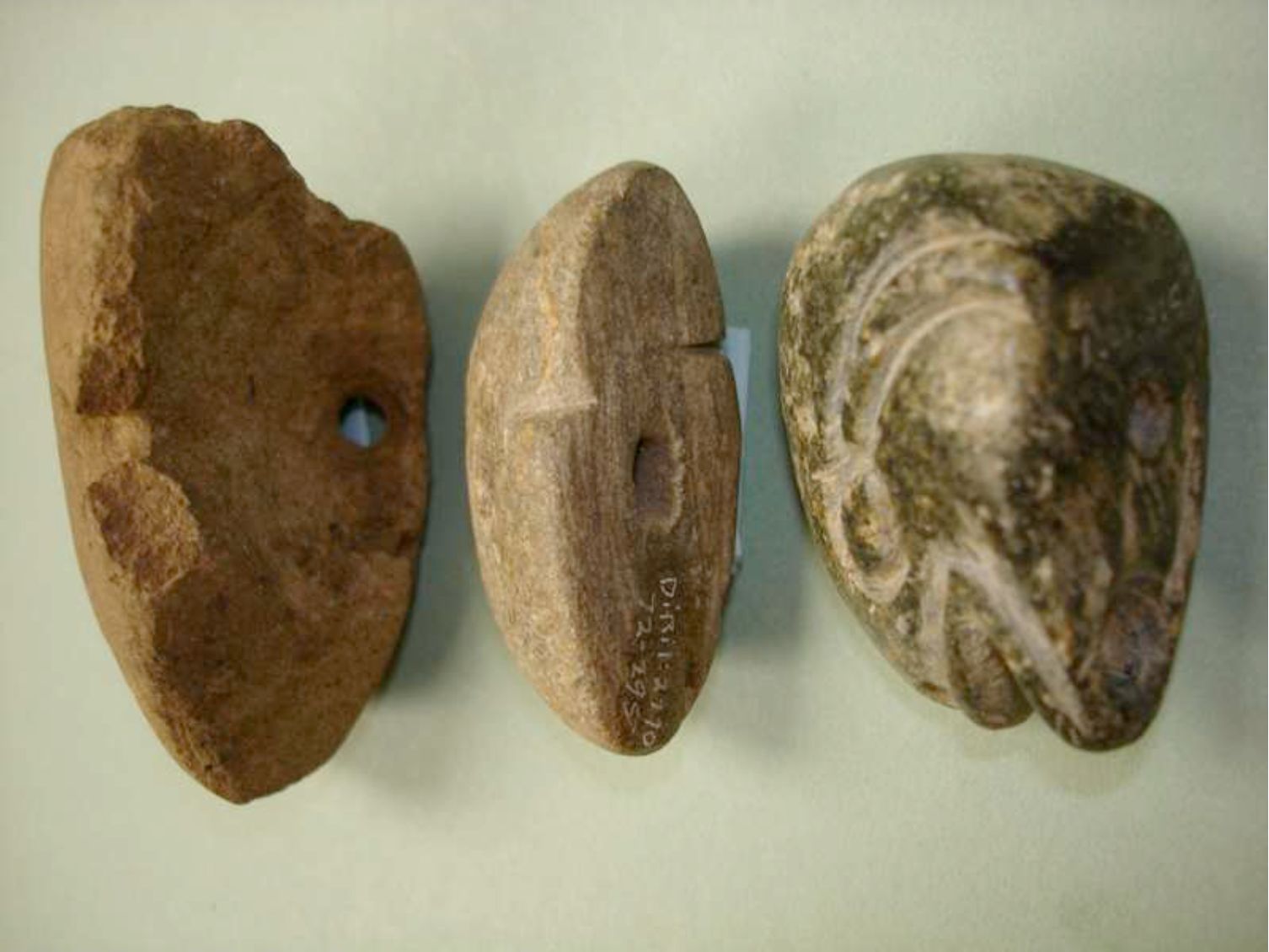
YALE DISTRICT
Three artifacts from the “Yale District” were part of the A. Croucher collection that was bequeathed to the RBCM in 1917. There are many small objects such as these that may be atlatl weights based on a similarity to others that are more obviously weights.
• DjRi-Y:14. Snake-like, or rattle-snake tail-like shape. Weight: 36.5 grams. Maximum L. 93mm. Head-like proximal end is L. 30mm, W. 18.2mm and H. 16mm. There are 6 incised rings encircling the body below the head-like portion. Material: Steatite.
• DjRi-Y:13. Snake-like. Weight: 20.8 grams. Maximum L. 95mm. Head-like proximal end is L. 21mm, W. 14.4mm and H. 10mm. The head has an incised mouth. There are 11 lines extending straight across the ventral side below the head. The dorsal body has a straight line roughly down the mid spine with small angled lines extending from the mid line to the side of the body. Material: Schist.
• DjRi-Y:11. Sitting human-like figure. Weight: 42 grams. Maximum L. 66.3mm. Width 26.8 and Thickness 15.8 of lower area around legs. Mid body thickness 13mm. The human is sitting on a round base. Elbows are bent at sides with arms resting on thighs. Material: Schist-like.

There are many atlatl weights that have been observed in private collections from the lower Fraser region. Some of these have been documented by the Archaeological Society of B.C.’s private collection photograph project done in the 1970s and others are in Museum photographs of private collections. A number of these are the common D-shaped types, but others include both human and other animal shapes. Figure 14, is an example of a small kneeling human figure (about 30mm high) with tie holes on the sides. Photographed by Wilson Duff in the early 1950s. Drawings of this and others appear in Duff’s Prehistoric Stone Sculpture of the Fraser River and Gulf of Georgia on page 146. In: Anthropology in British Columbia, No. 5, 1956, p. 14–I52.
PRIVATE COLLECTIONS
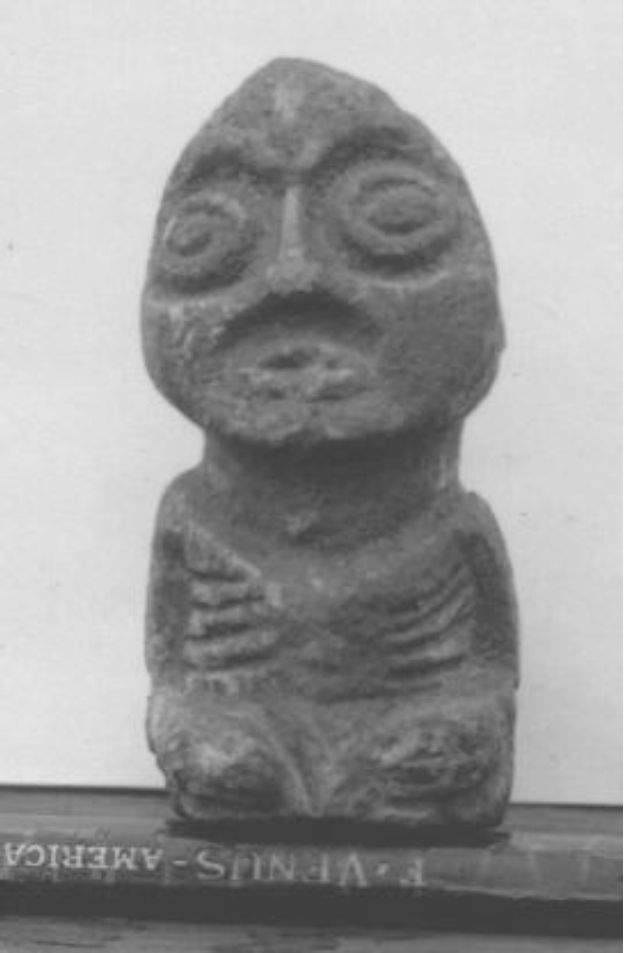
FRASER RIVER CANYON
weight from the Yale area. Private Collection.
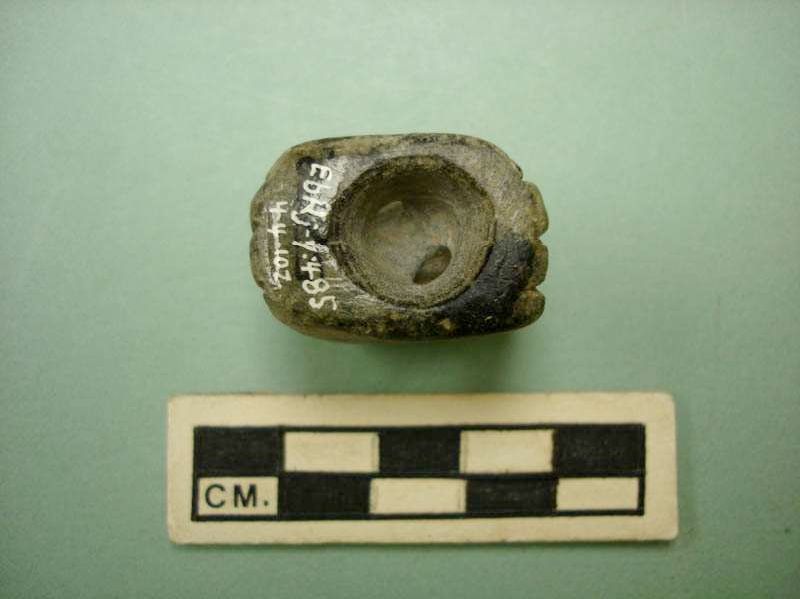

SELECTED BIBLIOGRAPHY RELEVANT TO THE STUDY OF ATLATL WEIGHTS IN NORTH AMERICA
Baker, W.E. and A.V. Kidder. 1937. A Spearthrower from Oklahoma. American Antiquity, 3:51-52.
Beatty, William H. 1972. Atlatl Weights or Boatstones. Papers in Anthropology, 8(1)34-49, University of Oklahoma, Norman, Oklahoma.
Bird, George. 1985. The Atl-Atl or Spear Throwing Stick. The Artifact, 23(3)7 & 18.
Borden, Charles E. 1969. The Skagit River Atlatl: A Reappraisal. B.C. Studies, 1:13-19.
Brown, Jeffrey, l. 1967. The Use of Atlatl Weights: a suggestion. Southwest Lore. 32(4)84-85.
Butler, Robert B. and Douglas Osborne. 1959. Archaeological Evidence for the use of Atlatl Weights in the Northwest. American Antiquity, 25(2)215- 224.
Butler, Robert B. 1961. Additional Notes and Comments on Atlatl Weights in the Northwest. Tebiwa, 4(1)29-31, Pocatello, Idaho.
Butler, Robert B. 1962. Additional Notes and Comments on Atlatl Weights in the Northwest. Utah Archaeology 9(2)10-14.
Butler, William B. 1975. The Atlatl: the Physics of Funtion and Performance. Plains Anthropologist. 22(68)105-110.
Butler, William B. 1977. The Atlatl functions, fancy, flex, and fun: a reply to Howard. Plains Anthropologist. 22(76) Part 1:161-162.
Cady, W. M. 1949. Remarks on the Weighted Atlatl. The Masterkey. 23(2)59-60.
Cressman, Luther S. and A.D. Krieger. 1940. Atlatls and Associated Artifacts from Southcentral Oregon. In: Early Man in Oregon, pp. 16-52. University of Oregon Monographs, Studies in Anthropology, No. 3. (eds) L. S. Cressman, Howell Williams and Alex Krieger. University of Oregon Press.
Cressman, Luther S. 1944. New Information on South Central Oregon Atlatls. Southwest Museum, Master Key 18(6)169-179, Los Angeles.
Davenport, J. W. 1943. Some Experiments in the Use of the Atlatl. Bulletin of the Texas Archaeological and Paleontological Society, 15:30-37.
Dickson, D.B. 1985. The Atlatl Assessed: A Review of Recent Anthropologiical Approaches to Prehistoric North American Weaponry. Bulletin of the Texas Archaeological Society, 56:1-38.
Duff, Wilson. 1956. Prehisotric Stone Sculpture of the Fraser River and Gulf of Georgia. In: Anthropology in British Columbia, No. 5:15-152 (see 75-77 & 146). British Columbia Provincial Museum, Department of Education, Victoria.
Ekholm, Gordon F. 1959. The Development of the Atlatl and the Bow. Bulletin of the Texas Archaeological Society, 30:159-162.
Ekholm, Gordon F. 1962. U-shaped “Ornaments” Identified as Finger-loops from Atlatls. American Antiquity, 28:181-185.
Fenenga, Franklin and Joe Ben Wheat. 1940. An Atlatl from the Baylor Rock Shelter, Culberson County, Texas. American Antiquity, 5(3)221-223.
Fenenga, Franklin and Robert Heizer. 1941. The Origin and Authenticity of an Atlatl and an Atlatl Dart from Lassen County, California. In: American Antiquity, 7:134-146.
Fenenga, Franklin and Robert Heizer. 1942. Further Notes on the Susanville Atlatl, American Antiquity, 8(2)120-122.
Fladmark, Knut R., D.E. Nelson, T.A. Brown, J.S. Vogel and J.R. Southon. 1987. AMS Dating of Two Wooden Artifacts from the Northwest Coast. Canadian Journal of Archaeology, 11:1-12.
Fladmark, Knut R. 1987. Two Atlatl Weights from the Southern Interior. The Midden. Journal of the Archaeological Society of B.C. , Vol. XIX, No. 1, P. 7-8, Feb.
Guernsey, Samuel James and Alfred Vincent Kidder. 1921. Basket-Maker Caves in Northeastern Arizona. Papers of the Peabody Museum of American Archaeology and Ethnology, 8(2), Harvard University.
Guernsey, Samuel James. 1931. Explorations in Northeastern Arizona. Report on the Archaeological Fieldwork of 1920-1923. Papers of the Peabody Museum of American Archaeology and Ethnology, Harvard University, Vol. 12, no. 1:71-72&Pls 48 & 50.
Grant, Cambell. 1979. The Spear-thrower from 15,000 Years Ago to the Present, Pacific Coast Archaeological Society Quarterly 15(1)1-17.
Guthrie, Dale R. 2002. Paleolithic Atlatl Weights and Their Decoration How Function Affects Fancy. In: Anthropological Papers of the University of Alaska. New Series, Vol. 2, no. 1, pp. 137-154. APUA, NS. Department of Anthropology, University of Fairbanks.
Harrington, M. R. 1959. A Two-Purpose Atlatl. Southwest Museum , Masterkey 33(2)60, Los Angeles.
Heizer, Robert F. 1938. An Inquiry into the Status of the Santa Barbara Spearthrower. American Antiquity, Vol. 4, No. 3.
Heizer, Robert F. 1938. A Complete Atlatl Dart from Pershing County Nevada. New Mexico Anthropologist, 11(4&5):69-71.
Heizer, Robert F. and I.W. Johnson. 1952. Atlatl Weights from Certain Sties on the Northern and Central Great Plains. Antiquity, 32(1)36-53.
Hester, Thomas R. 1974. Supplementary Notes on a Great Basin Atlatl. In: Great Basin Atlatl Studies, by T.R. Hester, M.P. Mildner and L. Spencer. Ramon: Ballena Press Publications in Archaeology, Ethnology and Hisotry, No. 2:29-31.
Hester, Thomas R. 1974. Archaeological Remains from NV-Wa-197:Atlatl and Animal Skin Pouches. Contributions, University of California Archaeological Research Facility. No. 21:1-36.
Hester, Thomas R.; Michael P. Mildner and L. Spencer. 1974. Great Basin Atlatl Studies.
Ramon: Ballena Press Publications in Archaeology, Ethnology and Hisotry, No. 2.
Hill, Malcolm W. 1948. The atlatl of throwing stick, a recent study of atlatls in use with darts of various sizes. Tennessee Archaeologist. 4(4)37-44.
Hill, Malcolm W. 1949. Atlatl Weight forms. Tennessee Archaeologist, 5(3).
Howard, Calvin D. 1974. The Atlatl: Function and Performance. American Antiquity, 39(1)102-104.
Howard, Calvin D. 1976. Atlatl Function: A reply to Butler. Plains Anthropologist. 74(21)313-314.
Hutchings, W. Karl and Lorenz W. Bruchert. 1997. Spearthrower performance: ethnographic and experimental research. Antiquity 71:890- 897.
Keddie, Grant. 1988. The Atlatl or Throwing Board. The Midden, Journal of the Archaeological Society of B.C., 20(5)6-8 & Cover.
Keddie, Grant and Erle Nelson. 2005. An Arrow From Tsitsutl Glacier, British Columbia. Canadian Journal of Archaeology. Volume 29:1:113-123.
Kellar, James H. 1955. The Atlatl in North America, Indiana Historical Society, Prehistory Research Series, 3(3)281-352, June, Indianapolis.
Krause, F. 1904. Sling Contrivances for Projectile Weapons. Smithsonian Annual Report for 1904. pp. 619-638.
Krieger, Alex D. 1956. Historic Survival of the Atlatl in the Lower Mississippi Region. Bulletin of the Texas Archaeological Society, 27:47-58.
Kwas, Mary L. 1981. Bannerstones as Chronological Markers in the Southeastern U.S. Tennessee Anthropologist, 6(2)144-171.
Mallam , R. Clark. 1971. An Atlatl Weight form Southeast Nebraska. Plains Anthropologist, 16(52)123-124.
Mason, John Alden. 1928. Some Unusual Spear Throwers of Ancient America. The Museum Journal, September, pp. 290-324, The Museum of the University of Pennsylvania. Philadelphia.
Mason, Otis T. 1884. Throwing-Sticks in the National Museum. Smithsonian Annual Report 1884, Vol. 2:279-307.
Massey, L. G. 1972. Tabla and Atlatl: Two Unusual Wooden Artifacts form Baja California. Pacific Coast Archaeological Society Quarterly 8(1)25-34.
Massey, William C. 1957. The Dart-Thrower in Baja California. In: Davidson journal of Anthropology, 3(1)439-446.
Massey, William C. 1961. The Survival of the Dart-Thrower on the Peninsula of Baja California. Southwestern Journal of Anthropology 17(1)81-92.
Mau, C. 1963. Experiments with the spearthrower, The Bulletin. New York State Archaeological Association, 29:2-15.
Metcalf, George and H. Carlson. 1971. An Atlatl Weight from North Dakota. Plains Anthropologist, 16(52)121-122.
Mildner, Michael P. 1974. Descriptive and Distributional Notes on Atlatls and Atlatl Weights in the Great Basin. In: Great Basin Atlatl Studies. Ramon: Ballena Press Publications in Archaeology, Ethnology and Hisotry, No. 2:7-27.
Nelson, E. W. 1899. The Eskimo about Bering Strait. Washington, DC. US Bureau of American Ethnology. 18th Annual Report, 1896-97, Part 1.
Neuman, Robert W. 1967. Atlatl Weights from Certain sites on the Northern and Central Great Plains. American Antiqiuty, 32(1)36-53.
Nordquist, Delmar. 1964. Two Atlatl Weights From Washington State. The Washington Archaeologist, October, 8(4^24-30. Washington Archaeological Society, Seattle.
Palter, John L. 1976. A new approach to the significance of the ‘weighted spear thrower’. American Antiquity, 41(4)500-510.
Patterson, L. V. 1975. The atlatl function: some comments. The Record. 31(3)5-6. Dallas Archaeological Society.
Patterson, L. V. 1977. Atlatl function: comments on Howard’s views. Plains Anthropologist. 22(76)Part 1:159-160.
Patterson, J. T. 1937. Boat-shaped artifacts of the Gulf Southwest States. University of Texas Bulletin 3732, Anthropological Papers, 1(2).
Payen, L. A. 1970. A Spearthrower from Potter Creek Cave, Shasta County, California. Papers on California and Great Basin Prehisotry, Center for Archaeological Research at Davis, (2)155-170.
Peets, Orville H. 1959. A Butterfly Bannerstone as an Atlatl Weight. Ohio Archaeologist 9:83-87.
Peets, Orville H. 1960. Experiments in the use of Atlatl Weights. American Antiquity 26(1): 108-110.
Pepper, George. 1905. The Throwing-Stick of a Prehistoric People if the Southwest. International Congress of Americanists, 13th Annual Session, pp. 107-130.
Perkins, W. R. and P. Leininger. 1989. The Weighted Atlatl Dart: A Deceptively Complicated Mechanical System. Part 1, The Atlatl, 3:1-3.
Perkins, W. R. 1993. Atlatl Weights: Function and Classification. Bulletin of Primitive Technology. 5:58-61.
Perkins, W. R. 1994. Effects of Stone Projectile Points as a Mass within the Atlatl and Dart Mechanical System. Bulletin of Primitive Technology 10:69- 72.
Raymond, Anan. 1986. Experiments in the function and performance of the weighted atlatl. World Archaeology 18(2)153- 177.
Quinn, J. W. 1964. Atlatl Weight form Northwest Nevada. Screenings.
Riddell, F. A. 1969. Atlatl Spurs from California. American Antiquity, 34(4)474-478.
Seaman, N. G. 1967 (1946). Indian Relic of the Pacific Northwest. Binfords & Mort, Publishers, Portland, Oregon. (see pages 82-85; 172-176).
Spencer, Lee. 1974. Replicative experiments in the namufacture and use of a Great Basin atlatl. In: Great Basin Atlatl Studies. pp. 37-60. (eds) T.R. Hester, M.P. Mildner and L. Spencer. Publications in Archaeology, Ethnology and Hisotry, No. 2. Ballena Press.
Strong, Emory. 1958. Evidence of the Atlatl in the Pacific Northwest. Screenings 7(4). Oregon Archaeological Society, Portland.
Strong, Emory. 1960. Stone Age on the Columbia River. Binfords & Mort, Publishers, Portland, Oregon. (see pages 164-168).
Strong, Emory. 1966. The McClure Atlatls. Screenings, may, 15(5)1-4. Oregon Archaeological Society, Portland, Oregon.
Swanton, John R. 1938. Historic use of the spear-thrower in southeastern North America. American Antiquity. 4:356-358.
Taylor, Herbert C. Jr. and Warren Caldwell, 1954. Carved Atlatl from the Northwest Coast. American Antiquity, 19(3^279-280.
Thomas, David Hurst. 1978. Arrowheads and Atlatl Darts: How the stones got the Shaft. American Antiquity, 43(3)461-472.
Tolley, Robert and Jack Barnes. 1979. Reinventing the Atlatl. Journal of the Stewart Anthropological Society. 10(2)161-172.
Tuohy, Donald R. 1982. Another Great Basin Atlatl and Dart Foreshafts and Other Artifacts: Implications and Ramifications. In: Journal of California and Great Basin Anthropology. 4(1)80-106. Published by Malki Museum, Inc, Morongo Indian Reservation, Banning, California.
Vaughan, Thomas. 1982. Soft Gold. The Fur Trade and Cultural Exchange on the Northwest Coast of America. Oregon Historical Society. [Four atlatls form the Peabody Museum, pp. 76-79]
Webb, William S. 1957. The Development of the Spearthrower. University of Kentucky Occassional Papers in Anthropology, No. 2:1-87.

